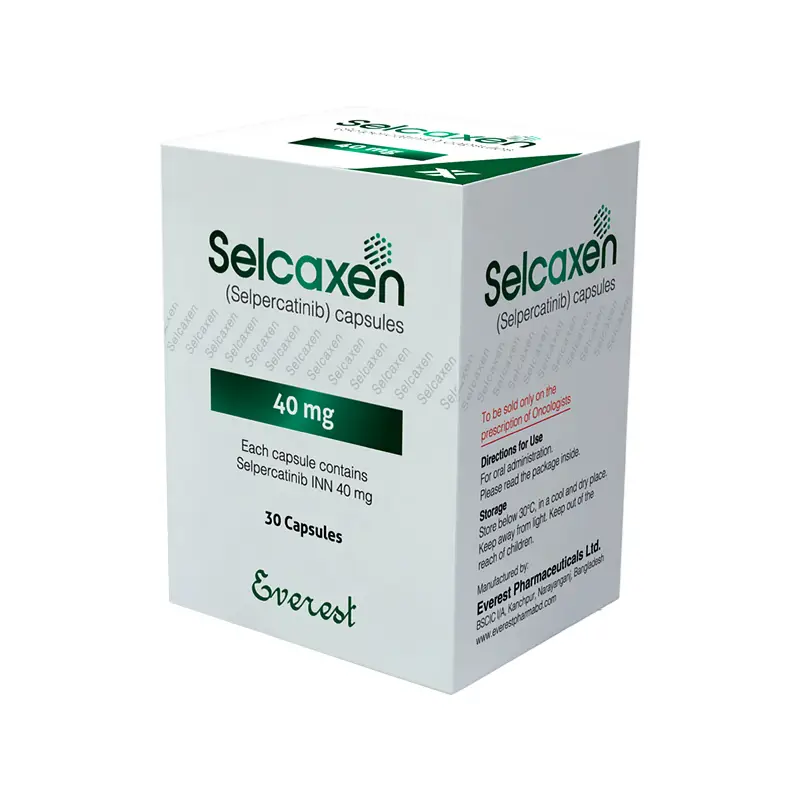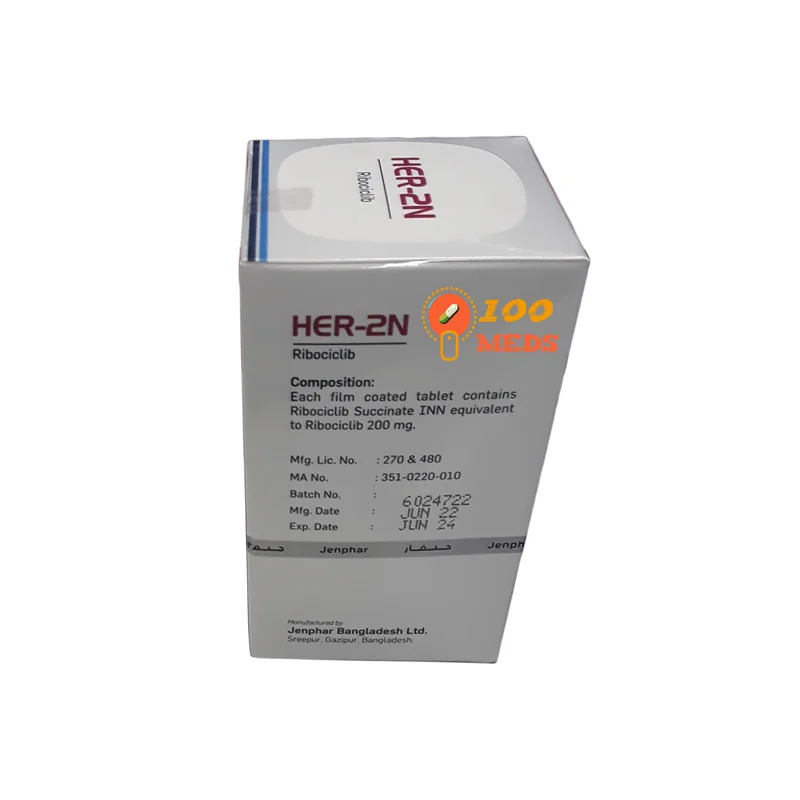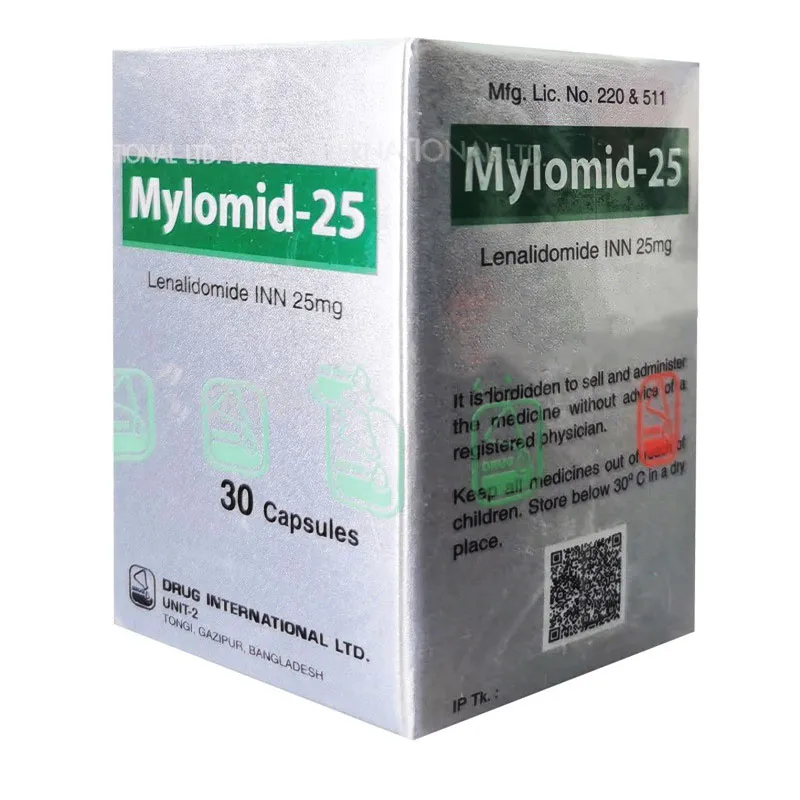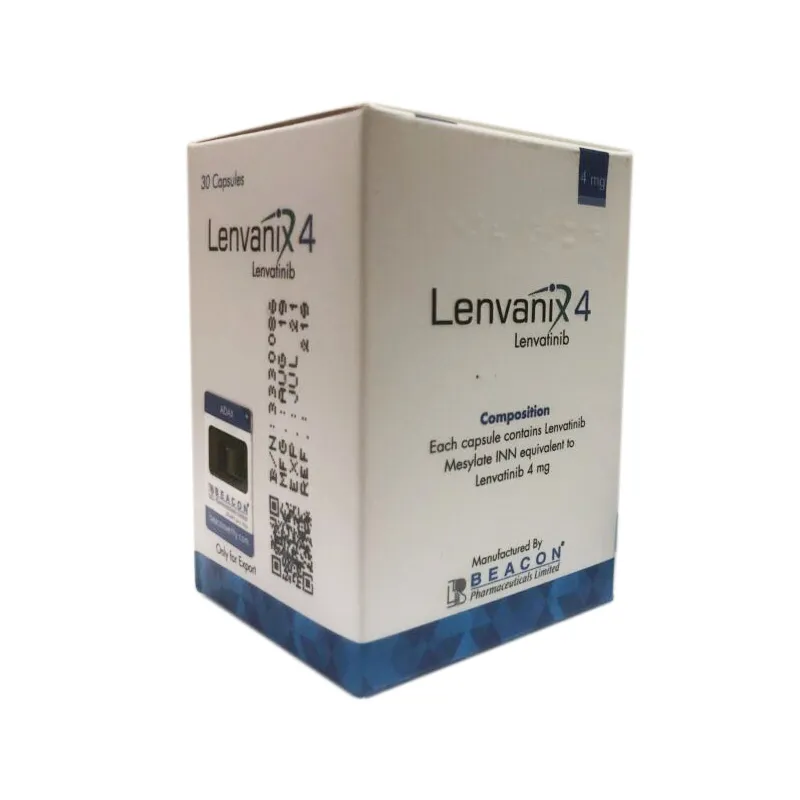Buy Generic Selpercatinib
Inquire UsDescription
Why is Selpercatinib prescribed?
Selpercatinib is used to treat a certain type of non-small cell lung cancer (NSCLC) in adults that has spread to other parts of the body in adults. It is also used to treat a certain type of thyroid cancer in adults and children 12 years of age and older that has spread to other parts of the body. Selpercatinib is also used to treat another type of thyroid cancer that has spread to other parts of the body in adults and children 12 years of age and older who have been treated unsuccessfully with radioactive iodine. Selpercatinib is in a class of medications called kinase inhibitors. It works by blocking the action of an abnormal protein that signals cancer cells to multiply. This helps slow or stop the spread of cancer cells. Information source: MedlinePlus.
Why should you buy the generic Selpercatinib online?
First of all generic Selcaxen is very affordable version of selpercatinib for non-small-cell lung carcinomas patients. It is a verified generic version of Retevmo. Everest pharmaceuticals Limited manufacture this generic version in Bangladesh. It is one of the renowned pharmaceutical companies who mostly made cancer medicine in Bangladesh. After the Directorate General of Drug Administration of Bangladesh approves to manufacture selpercatinib, they started to make it and sell it all over the world where generic medicine is allowed to use.
It is the first generic version of Retevmo which is selling regularly all over the world. It is also 88% cheaper than the brand version of selpercatinib. Which cost you less than 500 dollars. There are some other medicine available for NSCLC patients. Osimertinib is one of them. To know more you can visit our shop page.
COMPOSITION
SELCAXEN capsule: Each capsule contains Selpercatinib INN 40 mg.
PHARMACOLOGY
Mechanism of Action:
Selpercatinib is a kinase inhibitor. Selpercatinib inhibited wild-type RET and multiple mutated RET isoforms as well as VEGFR1 and VEGFR3 with IC50 values ranging from 0.92 nM to 67.8 nM. In other enzyme assays, Selpercatinib also inhibited FGFR 1, 2, and 3 at higher concentrations that were still clinically achievable. In cellular assays, Selpercatinib inhibited RET at approximately 60-fold lower concentrations than FGFR1 and 2 and approximately 8-fold lower concentration than VEGFR3.
INDICATION AND USAGE OF SELPERCATINIB
Metastatic RET Fusion-Positive Non-Small Cell Lung Cancer
Selpercatinib is indicated for the treatment of adult patients with metastatic RET fusion-positive non-small cell lung cancer (NSCLC). This indication is approved under accelerated approval based on overall response rate and duration of response. Continued approval for this indication may be contingent upon verification and description of clinical benefit in confirmatory trial(s).
RET-Mutant Medullary Thyroid Cancer
Selpercatinib is indicated for the treatment of adult and pediatric patients 12 years of age and older with advanced or metastatic RET-mutant medullary thyroid cancer (MTC) who require systemic therapy. This indication is approved under accelerated approval based on overall response rate and duration of response. Continued approval for this indication may be contingent upon verification and description of clinical benefit in confirmatory trial(s).
RET Fusion-Positive Thyroid Cancer
Selpercatinib is indicated for the treatment of adult and pediatric patients 12 years of age and older with advanced or metastatic RET fusion-positive thyroid cancer who require systemic therapy and who are radioactive iodine-refractory (if radioactive iodine is appropriate).
This indication is approved under accelerated approval based on overall response rate and duration of response. Continued approval for this indication may be contingent upon verification and description of clinical benefit in confirmatory trial(s).
DOSAGE AND ADMINISTRATION
Patient Selection
Select patients for treatment with Selpercatinib based on the presence of a RET gene fusion (NSCLC or thyroid cancer) or specific RET gene mutation (MTC) in tumor specimens or plasma. An FDA-approved test for the detection of RET gene fusions and RET gene mutations is not currently available.
Important Administration Instructions
SELPERCATINIB may be taken with or without food unless co-administrated with a proton pump inhibitor (PPI).
Recommended Dosage
The recommended dosage of Selpercatinib based on body weight is:
- Less than 50 kg: 120 mg
- 50 kg or greater: 160 mg
Take Selpercatinib orally twice daily (approximately every 12 hours) until disease progression or unacceptable toxicity.
Swallow the capsules whole. Do not crush or chew the capsules.
Do not take a missed dose unless it is more than 6 hours until next scheduled dose.
If vomiting occurs after Selpercatinib administration, do not take an additional dose and continue to the next scheduled time for the next dose.
Dosage Modifications for Concomitant Use of Acid-Re-ducing Agents
Avoid concomitant use of a PPI, a histamine-2 (H2) receptor antagonist, or a locally-acting antacid with Selpercatinib. If concomitant use cannot be avoided:
- Take Selpercatinib with food when co-administered with a PPI.
- Take Selpercatinib 2 hours before or 10 hours after administration of an H2 receptor antagonist.
- Take Selpercatinib 2 hours before or 2 hours after administration of a locally-acting antacid.
CONTRAINDICATION
None.
WARNINGS AND PRECAUTIONS
Hepatotoxicity
Serious hepatic adverse reactions occurred in 2.6% of patients treated with Selpercatinib. Monitor ALT and AST prior to initiating Selpercatinib, every 2 weeks during the first 3 months, then monthly thereafter and as clinically indicated.
Withhold, reduce dose or permanently discontinue Selpercatinib based on the severity.
Hypertension
Hypertension occurred in 35% of patients, including Grade 3 hypertension in 17% and Grade 4 in one (0.1%) patient. Overall, 4.6% had their dose interrupted and 1.3% had their dose reduced for hypertension. Treatment-emergent hypertension was most commonly managed with anti-hypertension medications. Do not initiate Selpercatinib in patients with uncontrolled hypertension. Optimize blood pressure prior to initiating Selpercatinib. Monitor blood pressure after 1 week, at least monthly thereafter and as clinically indicated. Initiate or adjust anti-hypertensive therapy as appropriate. Withhold, reduce dose, or permanently discontinue Selpercatinib based on the severity.
QT Interval Prolongation
Selpercatinib can cause concentration-dependent QT interval prolongation. An increase in QTcF interval to >500 ms was measured in 6% of patients and an increase in the QTcF interval of at least 60 ms over baseline was measured in 15% of patients. Selpercati-nib has not been studied in patients with clinically significant active cardiovascular disease or recent myocardial infarction.
Monitor patients who are at significant risk of developing QTc prolongation, including patients with known long QT syndromes, clinically significant bradyarrhyth-mias, and severe or uncontrolled heart failure. Assess QT interval, electrolytes and TSH at baseline and periodically during treatment, adjusting frequency based upon risk factors including diarrhea. Correct hypokalemia, hypomagnesemia and hypocalcemia prior to initiating Selpercatinib and during treatment.
Monitor the QT interval more frequently when Selperca-tinib is concomitantly administered with strong and moderate CYP3A inhibitors or drugs known to prolong QTc interval. Withhold and dose reduce or permanently discontinue Selpercatinib based on the severity.
Hemorrhagic Events
Serious including fatal hemorrhagic events can occur with Selpercatinib. Grade > 3 hemorrhagic events occurred in 2.3% of patients treated with Selpercatinib, including 3 (0.4%) patients with fatal hemorrhagic events, including one case each of cerebral hemorrhage, tracheostomy site hemorrhage, and hemoptysis. Permanently discontinue Selpercatinib in patients with severe or life-threatening hemorrhage.
SIDE EFFECTS
The most common side effects of Selpercatinib are:
- higher levels of liver enzymes
- higher blood sugar levels
- lower white blood cell count
- lower protein (albumin) levels in the blood
- lower calcium levels in the blood
- dry mouth
- diarrhea
- higher creatinine levels (this measures kidney function)
- high blood pressure
- tiredness
- swelling of your arms, legs, hands, and feet (peripheral edema)
- lower platelet count
- higher cholesterol levels
- rash
- lower salt (sodium) levels in the blood
- constipation
DRUG INTERACTIONS
Effects of other medicinal products on Selpercatinib
Acid-Reducing Agents
Concomitant use of SELPERCATINIB with acid-reducing agents decreases Selpercatinib plasma concentrations, which may reduce SELPERCATINI anti-tumor activity.
Avoid concomitant use of PPIs, H2 receptor antagonists, and locally-acting antacids with SELPERCATINIB. If co-administration cannot be avoided, take SELPERCA-TINIB with food (with a PPI) or modify its administration time (with a H2 receptor antagonist or a locally-acting antacid).
Strong and Moderate CYP3A Inhibitors
Concomitant use of SELPERCATINIB with a strong or moderate CYP3A inhibitor increases Selpercatinib plasma concentrations, which may increase the risk of SELPERCATINIB adverse reactions, including QTc interval prolongation. Avoid concomitant use of strong and moderate CYP3A inhibitors with SELPERCATINIB. If concomitant use of strong and moderate CYP3A inhibitors cannot be avoided, reduce the SELPERCATINIB dosage and monitor the QT interval with ECGs more frequently.
Strong and Moderate CYP3A Inducers
Concomitant use of SELPERCATINIB with a strong or moderate CYP3A inducer decreases Selpercatinib plasma concentrations, which may reduce SELPERCA-TINIB anti-tumor activity. Avoid co-administration of strong or moderate CYP3A inducers with SELPERCATINIB.
Effects of SELPERCATINIB on Other Drugs
CYP2C8 and CYP3A Substrates
SELPERCATINIB is a moderate CYP2C8 inhibitor and a weak CYP3A inhibitor: Concomitant use of SELPERCA-TINIB with CYP2C8 and CYP3A substrates increases their plasma concentrations, which may increase the risk of adverse reactions related to these substrates.
Avoid co-administration of SELPERCATINIB with CYP2C8 and CYP3A substrates where minimal concentration changes may lead to increased adverse reactions. If co-administration cannot be avoided, follow recommendations for CYP2C8 and CYP3A substrates provided in their approved product labeling.
USE IN SPECIFIC POPULATION
Pregnancy
Risk Summary
Based on findings from animal studies, and its mechanism of action, SELPERCATINIB can cause fetal harm when administered to a pregnant woman. There are no available data on SELPERCATINIB use in pregnant women to inform drug-associated risk. Administration of Selpercatinib to pregnant rats during the period of organogenesis resulted embryolethality and malformations at maternal exposures that were approximately equal to the human exposure at the clinical dose of 160 mg twice daily. Advise pregnant women of the potential risk to a fetus.
Lactation
Risk Summary
There are no data on the presence of Selpercatinib or its metabolites in human milk or on their effects on the breastfed child or on milk production. Because of the potential for serious adverse reactions in breastfed children, advise women not to breastfeed during treatment with SELPERCATINIB and for 1 week after the final dose.
Females and Males of Reproductive Potential
Based on animal data, SELPERCATINIB can cause embryolethality and malformations at doses resulting in exposures less than or equal to the human exposure at the clinical dose of 160 mg twice daily.
Pregnancy Testing
Verify pregnancy status in females of reproductive potential prior to initiating SELPERCATINIB.
Contraception
Females
Advise female patients of reproductive potential to use effective contraception during treatment with SELPER-CATINIB and for 1 week after the final dose.
Males
Advise males with female partners of reproductive potential to use effective contraception during treatment with SELPERCATINIB and for 1 week after the final dose.
Infertility
SELPERCATINIB may impair fertility in females and males of reproductive potential.
Pediatric Use
The safety and effectiveness of SELPERCATINIB have been established in pediatric patients aged 12 years and older for medullary thyroid cancer (MTC) who require systemic therapy and for advanced RET fusion-positive thyroid cancer who require systemic therapy and are radioactive iodine-refractory (if radioactive iodine is appropriate). Use of SELPERCATINIB for these indications is supported by evidence from adequate and well-controlled studies in adults with additional pharmacokinetic and safety data in pediatric patients aged 12 years and older. The safety and effectiveness of SELPERCATINIB have not been established in these indications in patients less than 12 years of age.
The safety and effectiveness of SELPERCATINIB have not been established in pediatric patients for other indications.
Monitor growth plates in adolescent patients with open growth plates. Consider interrupting or discontinuing therapy based on the severity of any growth plate abnormalities and based on an individual risk-benefit assessment.
Geriatric Use
Of 702 patients who received SELPERCATINIB, 34% (239 patients) were ≥ 65 years of age and 10% (67 patients) were ≥ 75 years of age. No overall differences were observed in the safety or effectiveness of SELPER-CATINIB between patients who were ≥ 65 years of age and younger patients.
Renal Impairment
No dosage modification is recommended for patients with mild to severe renal impairment estimated Glomerular Filtration Rate (eGFR) ≥15 to 89 mL/min, estimated by Modification of Diet in Renal Disease (MDRD) equation]. The recommended dosage has not been 2 established for patients with end-stage renal disease -(ESRD).
Hepatic Impairment
Reduce the dose when administering SELPERCATINIB to patients with severe [total bilirubin greater than 3 to 10 times upper limit of normal (ULN) and any AST] hepatic impairment. No dosage modification is recommended for patients with mild (total bilirubin less than or equal to ULN with AST greater than ULN or total bilirubin greater than 1 to 1.5 times ULN with any AST) or moderate (total bilirubin greater than 1.5 to 3 times ULN and any AST) hepatic impairment. Monitor for SELPERCATINIB related adverse reactions in patients with hepatic impairment.
OVERDOSE
Symptoms of overdose have not been established. In the event of suspected overdose, supportive care should be provided.
PHARMACEUTICAL INFORMATION
Storage Condition
Store below 30°C, in a cool and dry place. Keep away from light. Keep out of the reach of children.
HOW SUPPLIED
SELCAXEN capsule: Each HDPE container contains 30 capsules (each capsule contains 40 mg Selpercatinib INN) a silica gel desiccant and polyester coil with a child-resistant closure.
Buy Generic Selpercatinib
Are you interested to buy generic Selpercatinib online? Don’t worry. 100 Meds can help you to find reliable and verified medicine at affordable cost. Please contact our support team by using email, whatsapp or wechat. Even you can contact our facebook page.
You must be logged in to post a review.






Reviews
There are no reviews yet.